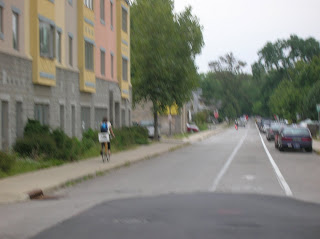And though it is a laudable goal to "encourage" people to ride their bikes to work or the store or to shopping and shows, many people fear riding their bikes through traffic. So, in order to gain the benefits of bicycles, the city needs to take affirmative steps toward getting people on their bikes. The single most effective way to do this is to make riding safer. And the single most effective way to make riding safer is to get more bikes on the road. hmmm....
Clearly, something else must be done to increase safety. In a previous post (Part I), I explained what the city could do better to make cycling safer around town. The proposals included adding more bicycle lanes, segregating bicycle lanes from traffic, and avoiding the "disappearing bike lane" at stoplights.
Although Bloomington has much to be chastised for regarding a lack of safety infrastructure around town, bicycle safety cannot be put wholly in the hands of city officials. Commuting safely through Bloomington also requires smart bicycling, and obeying traffic laws. It may appear that an idiot bicyclist (and I'm just going to call a spade a spade here because I think they are idiots) who refuses to obey the rules of traffic puts only himself at risk, but--alas--such is not the case.
The benefit of traffic laws is their gift of predictability. In other words, you, as participant in traffic, generally understand that others will be following the same rules as you, and thus you can predict with some accuracy what other vehicles will do in any given situation. This allows you to anticipate events and react accordingly. Hence, if you, driver, pull up to a four-way intersection where other cars have already stopped, you realize that there is some order to which each car will leave the intersection. And, if you are driving down a one-lane road, you have a justified expectation that vehicles will not be careening toward you.
All of these rules guarantee a degree of safety for you and for others. And the same must hold true for bicyclists. No good is served when a cyclist determines to make his own traffic rules. Such actions confuse drivers, who have no way of predicting what a cyclist will do, and diminishes safety for other bicyclists.
A case in point: many bicyclists seem to think that those red octagonal signs that say STOP in big, white letters do not apply to them. So when cars arrive at intersections where bicycles have also arrived and where both are supposed to stop, drivers are not sure whether they should procced when they have the right of way or wait and see what the bicycle will do. This causes also sorts of madness and frustration for everyone.
The three main violations I see around town that wreak havoc on predictability (and car, bicycle, and pedestrian safety) are: (1) riding the wrong way on one-way streets; (2) running not only stop signs but also traffic lights; (3) and riding on the sidewalk.
One-Way Streets:
 You, who feel so inclined, I think you are just big jerks. I don't think I need to spell out why this is dangerous and selfish.
You, who feel so inclined, I think you are just big jerks. I don't think I need to spell out why this is dangerous and selfish.
And it is not dangerous only to the idiot riding the wrong way. You also put me in danger because I have to worry about my safety from cars AND from you. Explain to me, sir, how we are both to fit in this narrow lane going in opposite directions? (I can't even get a clear shot from this direction)
Running Red Lights
This might seem like not such a big deal, right? When the intersection is clear, why not just ride straight through?
Look, bicycles are not children's toys. They are vehicles. They are modes of transportation. And, as such, they must obey the rules of the road. This is not just an inclination or feeling that I have. It is the law (an unenforced law, but still). The only way to improve safety for cyclists is for cyclists to be respected as equals of other vehicles. And the only way for that to happen is if we respect the rules of the road.
Riding on Sidewalks
Aside from the short (and slow) sidewalk trips that are required to arrive at the bike rack, rides on sidewalks are no-nos. Roads are for bicycles; sidewalks are for pedestrians. Otherwise, it is just dangerous for both. Not to mention rude.

 Not even trees in the middle of the sidewalk can stop these intrepid bikateers!
Not even trees in the middle of the sidewalk can stop these intrepid bikateers! bike lane, schmike lane.
bike lane, schmike lane.
Look, I'm not a saint. I've broken my share of traffic laws both in a car and on a bicycle. But I endeavor to ride my bike as I drive my car--obeying laws as much as I can humanly withstand. My general rule, and perhaps this can be a rule for us all: ride your bike as you would drive your car. And if you drive your car through red lights, the wrong way down one-way streets, and on sidewalks, there's not much more I can say.
1 comment:
In general, one way streets are a way of coping with too many cars in too small a place. In the city I live in, all the one way restrictions only apply to cars. Cyclists are exempt from the restriction because it means they can make more direct journeys as a resut.
Post a Comment